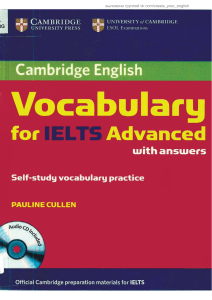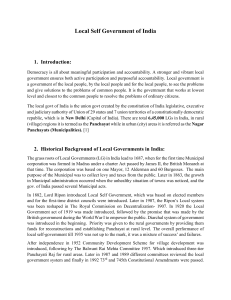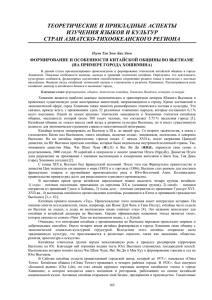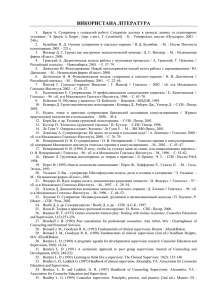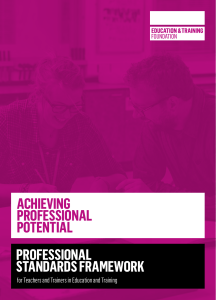Career Guidance in Secondary Schools - A Literature Review and Strategic
реклама
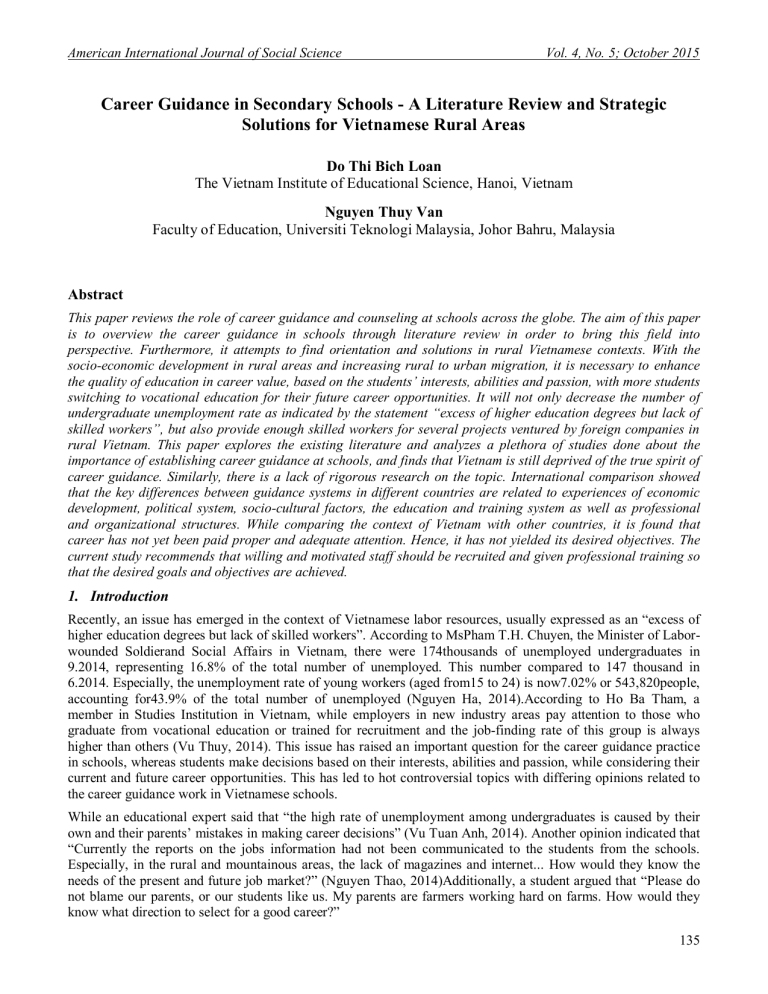
American International Journal of Social Science Vol. 4, No. 5; October 2015 Career Guidance in Secondary Schools - A Literature Review and Strategic Solutions for Vietnamese Rural Areas Do Thi Bich Loan The Vietnam Institute of Educational Science, Hanoi, Vietnam Nguyen Thuy Van Faculty of Education, Universiti Teknologi Malaysia, Johor Bahru, Malaysia Abstract This paper reviews the role of career guidance and counseling at schools across the globe. The aim of this paper is to overview the career guidance in schools through literature review in order to bring this field into perspective. Furthermore, it attempts to find orientation and solutions in rural Vietnamese contexts. With the socio-economic development in rural areas and increasing rural to urban migration, it is necessary to enhance the quality of education in career value, based on the students’ interests, abilities and passion, with more students switching to vocational education for their future career opportunities. It will not only decrease the number of undergraduate unemployment rate as indicated by the statement “excess of higher education degrees but lack of skilled workers”, but also provide enough skilled workers for several projects ventured by foreign companies in rural Vietnam. This paper explores the existing literature and analyzes a plethora of studies done about the importance of establishing career guidance at schools, and finds that Vietnam is still deprived of the true spirit of career guidance. Similarly, there is a lack of rigorous research on the topic. International comparison showed that the key differences between guidance systems in different countries are related to experiences of economic development, political system, socio-cultural factors, the education and training system as well as professional and organizational structures. While comparing the context of Vietnam with other countries, it is found that career has not yet been paid proper and adequate attention. Hence, it has not yielded its desired objectives. The current study recommends that willing and motivated staff should be recruited and given professional training so that the desired goals and objectives are achieved. 1. Introduction Recently, an issue has emerged in the context of Vietnamese labor resources, usually expressed as an “excess of higher education degrees but lack of skilled workers”. According to MsPham T.H. Chuyen, the Minister of Laborwounded Soldierand Social Affairs in Vietnam, there were 174thousands of unemployed undergraduates in 9.2014, representing 16.8% of the total number of unemployed. This number compared to 147 thousand in 6.2014. Especially, the unemployment rate of young workers (aged from15 to 24) is now7.02% or 543,820people, accounting for43.9% of the total number of unemployed (Nguyen Ha, 2014).According to Ho Ba Tham, a member in Studies Institution in Vietnam, while employers in new industry areas pay attention to those who graduate from vocational education or trained for recruitment and the job-finding rate of this group is always higher than others (Vu Thuy, 2014). This issue has raised an important question for the career guidance practice in schools, whereas students make decisions based on their interests, abilities and passion, while considering their current and future career opportunities. This has led to hot controversial topics with differing opinions related to the career guidance work in Vietnamese schools. While an educational expert said that “the high rate of unemployment among undergraduates is caused by their own and their parents’ mistakes in making career decisions” (Vu Tuan Anh, 2014). Another opinion indicated that “Currently the reports on the jobs information had not been communicated to the students from the schools. Especially, in the rural and mountainous areas, the lack of magazines and internet... How would they know the needs of the present and future job market?” (Nguyen Thao, 2014)Additionally, a student argued that “Please do not blame our parents, or our students like us. My parents are farmers working hard on farms. How would they know what direction to select for a good career?” 135 ISSN 2325-4149 (Print), 2325-4165 (Online) ©Center for Promoting Ideas, USA www.aijssnet.com As far as career guidance in schools is concerned, teachers usually talk in general, they are neither clear nor give any details. In the absence of clear and detailed counseling, it is unlikely that the students would choose the right career for future job market demands (Nguyen Thao, 2014). There is a common perception among most parents according to general social psychology in Vietnam and Asia, that getting enrolled their children at colleges and universities is the only way that leads to wealth and success. Hence, it can be seen that education and career guidance in Vietnamese schools face many challenges and obstacles, while the number of unemployed undergraduates are increasing unabatedly. With the current technological advances, new career opportunities are created rapidly and the jobs of today did not exist ten years ago (Casserly, 2012). Thus, today’s students need to be equipped to negotiate their way in a similar if not more complex future. The average student of today can expect to change jobs several times, often in completely different sectors. They must experience a further period of learning to update their skills on a lifelong basis. Therefore, career guidance in Vietnamese schools need to improve the quality of future career opportunities by bringing innovation directed towards substantive development, based on the trend of enhancing perspective career development from theories to value, attitude and practical action. The aim of this paper is to overview the career guidance in schools through literature review in order to bring this field into perspective. Furthermore, it tries to find orientation and solutions in rural Vietnamese contexts. The key differences between guidance systems in different countries are related to experiences of economic development, political system, socio-cultural factors, the education and training system as well as professional and organizational structures. Therefore, the following overview can find a suitable solution to Vietnam. 2. Literature review 2.1 Definition According to Watts and Fretwell (2004), career guidance and orientation services have been defined as services intended to assist individuals of any age and at any point throughout their lives, empowering them to make educational, training and occupational choices and to manage their careers. They include three main elements: (1) career information, (2) career counseling, and (3) career education (Watts & Fretwell, 2004, p.2). Career guidance in schools usually focuses on career information that provides information on courses, occupations and career paths. It also includes labor market information. The aim of Career counseling in schools is to hold one-on-one or small group interviews focused on the distinctive career issues faced by individuals, such as career in education. Being part of the educational curriculum, attention is paid to help groups of individuals to develop their competence to manage their career development. The role of Career Guidance is not only limited to education process but it also affects the national social and economic development. According to Watts (1977), formal Career guidance services are derived from economic and social development, playing a crucial role in helping to coordinate the education system and the labor market, in order to realize their goals successfully. Generally, the aim of career guidance is tohelp students make decisions based on their interests, passion and abilities, while taking into account current and future career opportunities. Students are encouraged to learn more about the world of employment across different industries, so that they may take right steps to obtain their objectives, goals and aspirations (MoE, Singapore). Another perspective indicated that career guidance can be referred to as services and activities intended to assist individuals of any age and at any point throughout their lives, to make educational, training and occupational choices and to manage their career (OECD, 2004). “Career guidance” denotes systematic programs that facilitate individual career development and career management (Herr & Cramer, 1996). As discussed above, career guidance renders services and activities that are geared towards helping individuals of any age at any point throughout their lives to make their educational training and occupational choices in order to manage their career OECD (2004). As it is pointed out by Herr and Cramer (1996), career guidance offers systematic programs that facilitate individual career development and career management. Career guidance is much more than mere face to face interviews: SCAGES (Standing Conference of the Association for Guidance in Education Settings UK 1992) recognized eleven different activities of career guidance, such as informing students about the current and future opportunities of job market advising, assessing, teaching, enabling, advocating, networking, giving feedback, managing and innovation or systems change. 136 American International Journal of Social Science Vol. 4, No. 5; October 2015 Yet another important role of career guidance in schools is to prepare students for the world of employment by equipping them with the right set of skills, so that they may stay relevant and fit into the global economy while leading a purposeful life. It is revealed by previous research evidence, that education along with career guidance have positive impact on the students’ academic performance and well-being, for they help them make good decisions regarding their education career. Education and career guidance is aimed at such goals as (1) fostering students’ self-awareness, self-directedness as well as skills to determine workable goals, and to learn consistently in order to add value to their future workplace; (2) assisting students to explore and make decisions based on valid information towards their education and career oriented directions; (3) instilling in their minds the value of utility for all sort of careers and how all these contribute towards the smooth and healthy functioning of the society; and last but not least, (4) equipping students with the skills and means by which they may be able to positively engage their parents and other career influencers (MoE, Singapore). 2.2 The Roles of Career Guidance in Socio-Economic Development, Labor Market Efficiency and the Education System It has been highlighted by researchers that career guidance has greatly contributed to national educational and labor market policy goals in terms of raising people’s interest in education and training as well as boosting their participation in formal and non-formal learning, which has positive effects on the overall learning outcomes. It empowers students by equipping them with better decision-making skills and making them well aware of learning opportunities (Killeen, White & Watts, 1992; Rosen, 1995; Watt, 1996). In addition, it increases job exploration and search activities among jobseekers, thus, it is proven to be helpful in reducing unemployment by informing people to improve their qualification and seek new kinds of jobs in different areas (Bysshe, Hughes & Bowes, 2002). Furthermore, an American study found that providing comprehensive guidance services to students at schools can have a positive impact on the quality of their educational and professional decisions, and also on their educational performance and the overall climate of the school (Lapan, Gysbers & Sun, 1997). It Supports Key Policy Objectives Ranging from Lifelong Learning to Social Equity In terms of learning goals, career guidance is important for it supports lifelong learning for both youth and adults and develops human resources to support national and individual economic growth. It also supports the development of a more flexible education and training system, strengthening the linkages between education/training systems and the labor market (Watts & Fretwell, 2004). Many countries across the globe acknowledge the value and importance of career guidance for it effectively supports education systems, establishes good curriculum and enhances the quality of human resources. Yet another important hallmark of career guidance is its role in fostering social equity. In some countries such as Finland, Germany and Norway, it is believed that career guidance is an important agent of the social integration of migrants and ethnic minorities, by bringing harmony between them. It can support the integration of the disadvantaged and the poorly qualified, and in employment it can address the growing polarization of the labor market, enhance the presence of females in the work force and address the issue of gender segregation in the labor market. Educational qualification and employment are important determinants of social mobility, and access to them is a key indicator of social equity (OECD, 2003). It Builds Human Capital and Employability throughout the Lifetime Career guidance is not limited to providing information about jobs and guidance to students in their decisions, but it also helps the youth in selecting their skills needed for developing and executing their long-term goals as a fundamental element of human capital (Gazier, 1999).The effectiveness of career guidance in assisting unemployed people requires individual action plans to be constructed, that involve such components as job search, education and training, stressing the ability to find and keep a job, and the personal capacity of adaptation to a changing labor market and the latest job requirements. Career management skills appear to play an important role in the formation and use of human capital and in the development of employability. 137 ISSN 2325-4149 (Print), 2325-4165 (Online) ©Center for Promoting Ideas, USA www.aijssnet.com 2.3 Career Guidance Approach around the World 2.3.1 Southeast Asia Singapore In Singapore, the Minister for Education, Mr Heng Swee Keat, indicated in 2014, that “Our education system must… nurture Singapore citizens of good character, so that everyone has the moral resolve to withstand an uncertain future, and a strong sense of responsibility to contribute to the success of Singapore and the well-being of fellow Singaporeans.” Education career guidance in Singapore is based on appropriate activities for students from primary to postsecondary school levels. The model shows education and career development as a process that takes place throughout one’s life. It is a framework that guides schools in coming up with a developmental span that contains three progressive phases, namely, career awareness, career exploration and career planning. The process of discovering one’s identity involves clarification of interests and values, understanding one’s strengths, developing abilities, and formulating life roles in the context of one’s life experiences. All these work towards building social and emotional competencies that help students become proactive, resilient and adaptable. Research by Perry, Liu and Pabian (2010) shows that when students see that there is a relevance between their studies and future career aspirations, they tend to exhibit more involvement and motivation in school. The ECG lessons will provide students with opportunities to explore and investigate various industries, jobs and possible further education options, enabling them to see the relevance between their studies and aspirations. This heightens learning motivation and engagement. In secondary school, the phase of education guidance career is to deepen students’ understanding of self and relate schooling to different education and career pathways. Students would (1) explore the world of careers; (2) understand the relevant courses of study; and (3) develop awareness of their skills, interests and values. The curriculum of career guidance in Singapore is divided in several main themes, including(1) self-awareness and self-management; (2) awareness of relational support and decision influencers; (3) exploring the education landscape and planning pathways and (4) career sectors exploration. It is an important policy goal to deliver the career guidance approach to all students including both individuals and groups. 138 American International Journal of Social Science Vol. 4, No. 5; October 2015 Malaysia The importance of career guidance can be gauged from the fact that it was introduced the(that time) Malayan education system as far back as 1939 (Llyod, 1986).This acknowledgment is documented in the Report on Vocational Education (1938) which highlighted the essential role of guidance services (Federation of Malaya, 1955) in schools. Maintaining that guidance services are important in schools, the following years (till the commencement of the Counselors Act 1998) saw guidance services, including career counseling, to transform into helping services in the educational system (Quek, 1999a; 1999b; 2000a). Even though career guidance was introduced as early as 1939, however, its launch in schools only took place in 1967. In 1967, a circular was published, which proposed that every primary and secondary school should appoint a guidance teacher who should teach about 25 periods of classroom teaching per week (as against the usual 30 approximately) and should be exempted from extra-curricular duties. The guidance teachers’ role was defined mainly in terms of career guidance, though they were also expected to interview pupils about personality and behavioral problems, to visit pupils' homes if and when necessary, to be responsible for the environmental health conditions of the school and, wherever possible, to organize Parent-Teacher Associations. In Malaysia school career counselors play an important role by preparing the students’ successful transition to the next level, whether toward further education or toward employment. School counselors provide career development interventions in a new paradigm which focuses not only on a career decision making but also on providing assistance to attain the necessary employability and self-management skills (Jarvis & Keeley, 2003). They help students who are unable to access and gain from market-driven occupational proficiencies, retrieve and disperse information through technology and, last but not least, retain students’ motivation and self-directedness. Career development is a continuous process that involves personal experiences in various aspects of life, influencing one’s career over one’s entire lifespan (Cassie, 2005; Dykeman, Herr, Ingram, Pehrsson, Wood & Charles, 2003; Niles & Harris-Bowlsbey 2007). Career development intervention should assist students to cope with different and diverse roles and preparing them for the futuristic challenges through career education, coaching and counseling. Previously, different strategies have been adopted to study the career choice and development. Yet, the experiences from the career guidance in Malaysia can be summarized into four major points, the first one being the guidance being taught during the initial teacher training. Secondly, the provision of guidance in primary schools – an American experience based approach. Thirdly, the provision of guidance through career clubs that arrange debates, talks and searches for occupational information. Finally, the guidance practice includes the encouraging of self-employment. 2.2.2 Developed Countries in Asia Hong Kong A “committee-based” system have evolved in schools since the 1980’s. This includes the guidance committees, disciplinary committees, life-education committees and community services committees. The main goal of establishing such committees was to prepare students for learning, employment and life through an experience of comprehensive and balanced learning in the academic setting. These objectives were believed to be attainable by providing students with more work-related experiences. Teachers are the most important human resources in pastoral care and teaching. However, if necessary supportive factors are lacking, they may face emotional and physical stress. The amount of teaching responsibilities they are relieved from is very limited, probably no more than 2 or 3 lessons per week. The most common practice in secondary schools is that each teacher is expected to be member of at least two committees together with one’s role as class teacher. At the same time, some teachers are unwilling to be involved in such committees due to the complexity of career information and lack of interest or concern. Presently, the Career Guidance Services (CGS) Section of Education Bureau provides support to schools by developing various assessment tools. In addition to the CGS, local mass media are keen in providing career information to the students and their parents at the time of the release of public examination results. Japan The Japan Ministry of Health, Labor and Welfare (MHLW) have introduced a more efficient strategy to help midcareer and older workers in career choices (MHLW, 2001). 139 ISSN 2325-4149 (Print), 2325-4165 (Online) ©Center for Promoting Ideas, USA www.aijssnet.com The Japanese government decided to use the terms “career consultation” and “career consultants” instead of “career counseling” and “career counselor” due to the ambiguity in the concept of counseling. The aim of the consultation is to align the workers’ needs for career formation with the enterprise requirements. Until the 1990’s, the Japanese human resource management system used to embody young people, especially the fresh graduates on long-term employments. A Job-specific skill was not a prerequisite of hiring new graduates (Nomura, 2007). However, since the 1990’s the labor market has dramatically changed. Companies have reduced the hiring of fresh graduates on permanent long term basis, increasing the role of non-regular part time employment and outsourcing. This shift in the employment trends has increased the youth unemployment rate two-fold in ten years. In Japan, the “homeroom teacher” system has been adopted that requires class teachers to take up all aspects of guidance and counseling and they are the first line of defense in pastoral care work. 2.2.3 Developed Countries beyond Asia New Zealand The National Administration Guideline provides career guidance and education for all students, with a particular emphasis on providing specific career guidance for those students who have been identified as being at a risk for leaving the school unprepared for further education/training or workplace. In New Zealand career education and guidance emphasize the need for students to develop career management competencies that includes (1) developing self-awareness, (2) exploring opportunities and (3) taking appropriate actions. United States In the US school counselors in middle and high schools have the responsibility to provide counseling and guidance to students, including various aspects of academic and career related problems or decisions. Regarding career guidance, school counselors are required to provide a basis for acquiring knowledge, attitudes and skills that will enable the students to make a successful transition into the labor market as well as from job to job across their career in life span. In middle schools six to eight school counselors assist students in career development through self-assessment activities, comparing middle school with high school and using assessment results. Students are expected to draw a relationship between interests and aptitudes and make smart long-term career decisions. Thus, school counseling programs play a pivotal role in preparing students for successful transition to the next level of education or joining the workforce (Feller 2003). 2.4 A comparison of career guidance in Vietnam and other countries Like other countries, Vietnam has established the career guidance program in its educational system, with the direction from the Government: “Promoting divide into different ways for postsecondary in education; paying attention in career orientation in high school", "Ensuring for secondary students commonly have enough knowledge platform to meet the requirements following strong high school or vocational education; High school graduates have access to vocational and prepare for quality higher education” (Resolution 29-NQ of Vietnamese Government, 2013). However, in the implementing process there are many challenges to improve career guidance affairs in Vietnam. In 2006 the Vietnamese Ministry of Education established the career guidance curriculum at grade 9 of secondary school. Following that, students study career development three periods a month, equal to one credit course per year. However, to many complaints by teachers about the school schedule heavy with many subjects, the career guidance curriculum decreased to one period per month in 2008, accounting for half a credit per year while it is at least one credit course in other countries. Due to the shorter duration of career guidance, it was complemented by other subjects and additional services outside the school. However, the assessment of career guidance in Vietnam lacks validity and reliability researches, and is normally met with some arguments by leaders, like as “career guidance in Vietnam has not received adequate attention, the effectiveness of career guidance in both schools and postsecondary vocational education is low, failing to meet the objectives” (Tran T Thu, 2013). The objectives, contents, methods and forms career guidance in Vietnamese secondary schools have not caught up with the demands of the present labor market and modern society (Vu D Chuan et al, 2013). Few students are encouraged to study in vocational education while almost 60% of the students in high schools fail the entry exam to higher education. 140 American International Journal of Social Science Vol. 4, No. 5; October 2015 At the same time, 20% of secondary school graduates go directly to labor market without any training for common work like famers, gardeners and pig or poultry breeders. Many of them get embarrassed by their actual work while their schools failed to orient them to a career path they can accept (Tran T. Thu, 2013). In Ireland’s secondary schools there is one guidance counselor for every 500 students. They are required to have a post-graduate diploma in guidance in addition to their teaching qualification. On the contrary, in Vietnam career guidance counselors in secondary schools are picked up from the existing teaching staff for the career development of the students, thus imposing extra work on them. Lack of human resources and material resources in career guidance, in terms of both quality and quantity, is a common phenomenon in most of Vietnamese schools (Chau Nguyen, 2013). Career guidance staff has not been trained adequately as professional or expert, therefore they lack the necessary knowledge, skills and experience in the career guidance process. Moreover, their work load is similar to their common colleagues, while career guidance is considered as no more than a kind of additional work that cannot be compared with teaching in class. In a workshop of career guidance in Ho Chi Minh City, the causes for the ineffectiveness of the Vietnamese career guidance practice were identified as the lack of knowledge, skills and experiences, most of the teachers encouraging their students to continue their study at high schools while paying less attention to vocational or technical schools, and students making career decisions which are not based on their personality, interests, skills and values. Another weakness is that the school managers have low incentive and motivation for both teachers and students. Almost no career guidance takes place at lower school education and only few activities have been done at Upper School Education. (Nguyen Chau, Minh Luan, Pham D Khoa & Nguyen T N Vu, 2013). 2.5 The trend of Rebuilding of Rural Areas in Vietnam in the period 2010- 2015 and Directional Solution for Career Guidance. In Vietnam economic transformation has made labor an indispensable criterion of raising the citizens’ living standard. As claimed by the National Target Program for the improvement and development of the new rural areas by 2020, the government has to pay attention to certain areas such as the content for the development of production, increase of income among the rural population and the alleviation of poverty. This should be linked to the implementation of the agricultural policy, geared towards higher value-added and sustainable development in the countryside. Researches, along with science and technology transfer being the top priority; the applicable agricultural model is defined as building advanced high-tech techniques to improve the quality of agricultural production. Upgrading new rural areas must be linked to a restructuring of the industry, the development of industrial support for agriculture and rural areas, particularly by the processing industry and the manufacturing of agricultural machinery, along with the electrification of the countryside, the mechanization of agriculture and the introduction of small and medium countryside mount to rearrange agricultural labor" ("The results of implementing the national target program on new rural construction phase 2010 – 2014, orientations and tasks until 2020 ". 5/2014). This move transformed the value-oriented profession and career choices of students, which requires, accordingly, the reform of vocational education to suit the new context. The high influx of migrants from rural areas to the cities in Vietnam leads to various socio-economic problems such as the slowing development and an increase in urban population, which will require more facilities and improvement. In addition, it can also contribute to other problems such as traffic congestion, employment issues, the emergence of social evils and the overcrowding of urban schools. Hence, career guidance in rural areas needs to improve its value by enhancing or introducing trends of economic development through public or foreign investment to the rural areas of Vietnam where rich human resources are available at reasonable cost. Thus, encouraging the students’ interest in vocational education, especially in technical careers will help them adapt to the labor capacities in social technology, and also to increase the number of this group to adequately provide labor resources for investing companies. Simultaneously, continuing the development of traditional careers in rural areas is also essential as it will boost high quality export of unique products abroad and ensure the conservation of Vietnam’s rich culture. Lastly but most importantly, it will enhance the living standard of rural citizens. 2.6 Conclusion Career guidance has existed in schools for a long time, aimed at assisting students to reflect on their ambitions, interests, qualifications and abilities. It helps them to understand the labor market and education systems, and to relate this to their needs in life and to become responsible global citizen. 141 ISSN 2325-4149 (Print), 2325-4165 (Online) ©Center for Promoting Ideas, USA www.aijssnet.com Comprehensive career guidance is aimed at teaching students to plan and make their decisions about work and learning, and to manage their career skills as well as career development. Career guidance provides information about the labor market and about educational opportunities, making them more accessible by organizing, systematizing and showcasing the information when and where people need it. In some countries career guidance is well-organized, engaging a high quality staff who have been trained for the purpose and have rich experience. However, in case of Vietnam, it happens to be poor in quality, for Vietnam is a developing country in Southeast Asia. Finding and implementing multiple solutions to improve quality of career guidance in Vietnamese schools will offer access to good life for individuals and also facilitate sustainable development for the whole country. This research is funded by Vietnam National Foundation for Science and Technology Development (NAFOSTED) under grant number VI1.2-2013.30". References Bysshe, S., Hughes, D., & Bowes, L. (2002). The economic benefits of career guidance: a review of current evidence. Centre for Guidance Studies, University of Derby. Casserly, M. (2012). The 10 skills that will get you hired in 2013. Retrieved May, 20, 2014.http://ridatahub.org/media/assets/The%2010%20Skills%20That%20Will%20Get% Orndorff, R. M., & Herr, E. L. (1996).A comparative study of declared and undeclared college students on career uncertainty and involvement in career development activities. Journal of Counseling and Development: JCD, 74(6), 632. Killeen, J., White, M., & Watts, A. G. (1992). The economic value of careers guidance (No. 702). London: Policy Studies Institute. Collin, A., & Watts, A. G. (1996). The death and transfiguration of career–and of career guidance?. British journal of Guidance and Counselling, 24(3), 385-398. Dykeman, C., Wood, C., Ingram, M., & Herr, E. L. (2003). Career Development Interventions and Academic Self-Efficacy and Motivation: A Pilot Study. Fowkes, K. M., & McWhirter, E. H. (2007). Evaluation of computer-assisted career guidance in middle and secondary education settings: Status, obstacles, and suggestions. Journal of Career Assessment, 15(3), 388-400. Gazier, B. (2002). Transitional labour markets: from positive analysis to policy proposals. The Dynamics of Full Employment–Social Integration through Transitional Labour Markets, Cheltenham, UK: Edward Elgar, 196-232. Feller, R. W. (2003).Aligning school counseling, the changing workplace, and career development assumptions. Professional School Counseling, 9(3), 262-271. Ho, Y. F. (2008). Reflections on school career education in Hong Kong: Responses to Norman C. Gysbers, Darryl Takizo Yagi, and Sang Min Lee & Eunjoo Yang. Asian Journal of Counseling, 15(2), 183-206. Hui, E. K., & Chan, D. W. (1996). Teacher stress and guidance work in Hong Kong secondary school teachers. British Journal of Guidance and Counselling, 24(2), 199-211. Jarvis, P. S., & Keeley, E. S. (2003). From vocational decision making to career building: Blueprint, real games, and school counseling. Professional School Counseling,6(4), 244-250. Lapan, R. T., Gysbers, N. C., & Sun, Y. (1997). The impact of more fully implemented guidance programs on the school experiences of high school students: A statewide evaluation study. Journal of Counseling & Development, 75(4), 292-302. Loh, S. Y., Than, W., & Quek, K. F. (2011). Occupational Pressure–Targeting Organisational Factors to Ameliorate Occupational Dysfunction. Journal of occupational rehabilitation, 21(4), 493-500. Mariño, R. J., Morgan, M. V., Winning, T., Thomson, W. M., Marshall, R. I., Gotjamanos, T., & Evans, W. (2006). Socio demographic backgrounds and career decisions of Australian and New Zealand dental students. Journal of Dental Education, 70(2), 169-178. Nguyen Ha (2014), 174 thousand undergraduates are unemployment, retrieved on 28.7.2015 at http://vneconomy.vn/thoi-su/174-ngan-cu-nhan-dang-that-nghiep-20141116071044639.htm. Nguyen Thao (2014), Tranhcãithấtnghiệplà do hướngnghiệpnhầm retrieved on 28.7.2015 at http://vietnamnet.vn/vn/giao-duc/167691/tranh-cai-that-nghiep-la-do-huong-nghiep-nham.html New Zealand Career Education Benchmark: http://www2.careers.govt.nz/benchmarks/. 142 American International Journal of Social Science Vol. 4, No. 5; October 2015 Nguyen T. Chau (2013) Bring career guidance to Vietnam’s secondary school, presentation in VVOB workshop. Othman, A. H., & Aboo-Bakar, S. B. (1993).Guidance, counseling, and counselor education in Malaysia. Counseling in the Asia-Pacific region,2(1), 1-25. Perry, J. C., Liu, X., & Pabian, Y. (2010). School engagement as a mediator of academic performance among urban youth: The role of career preparation, parental career support, and teacher support. The Counseling Psychologist,38(2), 269-295. Tran T. Thu (2013), Career guidance through vocational education in school, retrieved on 15.07.2015 at: http://www.vvob.be/vietnam/files/s1_mrs._thu_cg_through_egp_vn.pdf Vũ Đ. Chuẩn, Lê T. Tuấn, Trần T. Thu, Nguyễn T. Châu, & Hồ P. Hoàng (2013), Innovation of career guidance in school. Vietnamese Educational Ministry. Vu Thuy (2014), 162 thousand undergraduates are unemployment, retrieved on 28.7.2015 at http://tuoitre.vn/tin/chinh-tri-xa-hoi/20140820/%E2%80%8Bthua-thay-thieu-tho-hon-162000-cu-nhanthat-nghiep/636316.html Vu Tuan Anh (2014), Unemployment causes of mistakes in career decision, retrieved on 28.7.2015 http:// Vietnamnet.vn/vn/giao-duc/167413/that-nghiep-la-do-sinh-vien-chon-nhamsan.html20You%20Hired%20In%202013%20-%20Forbes.pdf Watts, A. G., & Fretwell, D. H. (2004).Public Policies for Career Development. Case Studies And Emerging Issues For Designing Career Information And Guidance Systems In Developing And Transition Economies. World Bank Education Advisory Service. Watts, A. G. (1977). Careers education in higher education: principles and practice. British Journal of Guidance and Counselling, 5(2), 167-184. Watanabe-Muraoka, A. M., Michitani, R., & Okada, M. (2009).A perspective on career counselling in Japan. Asian Journal of Counselling, 16(2), 171-191. Websites: http://www.thanhnien.com.vn/giao-duc/huong-nghiep-cho-hoc-sinh-con-chieu-le-471862.html http://www.moe.gov.sg/education/programmes/social-emotional-learning/education-career-guidance/ (Singapore) http://www.careers.govt.nz/plan-your-career/helping-young-people-make-decisions/what-help-should-schoolsprovide-with-careers/ (New Zealand) 143
